Tulapur
Tulapur is a village in Pune district, Maharashtra, India,[1] associated with the last moments of Sambhaji, son of Shivaji Maharaj.
History
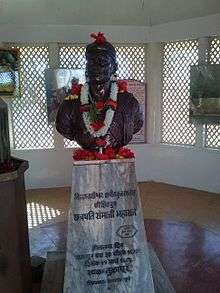
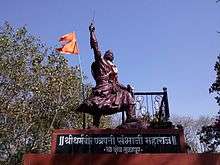
Tulapur has great significance in Maratha history. Chhattrapati Sambhaji was brought to Tulapur to be tortured and executed after he was captured by Mughal forces. Sambhaji was originally captured in Sangameshwar, a renowned Hindu holy place in Ratnagiri, about 40 miles west of Shrirangpur in Western India. Note: The Sangameshwar temple located at Tulapur should not be confused with the place called Sangameshwar.
Sambhaji had recently visited Shrirangpurto to resolve a family dispute before arriving at Sangameshwar. Ganoji Shirke led Sheikh Nizam Hyderbadi (later known as Muqarrab Khan, a title bestowed by Aurangzeb) through dense and inaccessible Sayadari jungles via Ambay ghat in order to ambush and arrest Sambhaji.[2] Sambhaji could have easily escaped with the early warning of the arrival of Mogul forces by his spies. Sambhaji also had better horses, and could outrun the enemy forces who were exhausted from their approach through the hills and passages of Sayadari. Some of his forces safely retreated to Raigad on his advice. However, it is unknown why he stayed and fought with such a small force.
A place with more than 360 ancient Hindu temples. Sambhaji was a great devout of Lord Shiva and was paying his respects at the holiest place. The false propaganda was to malign him for political gains by his enemies. When humiliated before Aurangzeb, Sambhaji was singing praises of Lord Shiva , thus affirming the fact that his presence at the holy place was for religious purposes only. He thoroughly fell in trance with Lord Shiva before capture, not very uncommon among devotees visiting Sangameshwar for pilgrimage.
Ganoji's relations and treachery with Bhosales are very interesting. Ganoji was the brother of Sambhaji's wife, Yesubai, and was also married to Shivaji's daughter Rajkunvarbai from Sagunabai. Sagunabai was also the sister of Ganoji's father Pilaji Shirke, and therefore a paternal aunt of Ganoji. Ganoji requested rich port vatan (Jagir) of Dabol from Sambhaji, just like his father, Pilaji, unsuccessfully tried to obtain the same from Adilshah first and later Shivaji. Vatandari(fiefdom) system was abolished by Shivaji due to its malpractices on people and Swaraj, therefore, Ganoji was unhappy with the unfulfilled ambition. Ganoji was offered this Vatan by Moguls if he colluded with them against Sambhaji.
With Ganoji's contrived help, captive Sambhaji was taken to Bahadurgad, near Akluj. There were no rescue attempts made while prisoners were moved through hostile Maratha territory, affirming bigger state players were at work against the fall of Sambhaji. During Sambhaji's nine year reign, several within his campaign and family wanted him ousted.
Aurangzeb, after humiliating and blinding Sambhaji, sent him towards Koregaon for further torture and punishments. In Tulapur, he was subjected to brutal torture over many weeks before he was executed. This is well documented by Aurangzeb's own Mogul officers and records. Niccolao Manucci, an Italian artillery officer in Aurangzeb's service, mentions in his memoirs that Sambhaji's side was injured by an axe and that his heart was removed while alive.
Aurangzeb ordered Sambhaji's head paraded through different cities. His head without skin was probably found in bushes near Vadhu village as Vadhu people cremated him there . Vadhu is located on the opposite side of Triveni river(Bhima river) and the people may have also found body parts of Sambhaji downstream, which they claim to have stitched. These people henceforth called Shivale(those who stitched) as a mark of respect to their brave work of cremation. Aurangzeb prohibited anyone from the cremation, hence the brave work. The skin of the head was filled with straw and displayed in various cities, finally hanged on gates of Delhi city, as per Ishwardas Nagar's memoir, Futuh-i-Alamgiri. Ishwardas Nagar was an eyewitness and employee of Aurangzeb, but he wrote without any bias towards Mogul or Marathas. His memoirs were not known to Aurangzeb and were considered a personal diary to record events .
Sambhaji was executed by Aurangzeb on 11 March 1689 on account of his fight for Swaraj and bravery against the latter. Along with Sambhaji, his poet-friend Kavi Kalash was also killed by Aurangzeb at the same place. Kalash died within 4 days from torture, while his King suffered 40 days bravely under torture in Tulapur. Although, there remains a dispute as to the place of torture and execution between three places, Koregaon Bhima, Vadhu or Tulapur. They all are very close to each other on the banks of Bhima river, which were traversed by a vast Mogul army frequently due to the availability of water and resources.
The place Vadhu was visited by his wife Yesubai and son Shahu many decades later after their release from Mogul captivity. Aurangzeb later removed himself towards Islamabad fort (Chakan fort) as given in Masir-i-Alamgiri. Aurangzeb traveled by Bhima river in his tours to support his big army.
The Emperor, Aurangzeb, felt jubilant after the demise of the Maratha Emperor, but this was very short-lived. The brutal murder of their beloved Chattrapati angered and filled Maratha heart with vengeance and fire. Sambhaji's death did what he couldn't do when he was alive, a mass freedom movement against the Mogul Empire and Aurangzeb.
Shortly after, at Tulapur, a great Maratha warrior and guerrilla tactician Santaji Ghorpade with his few followers secretly attacked at the heart of vast and impenetrable Mogul campaign, Aurangzeb's tent, by cutting its supporting ropes and killing everyone inside it. Initial belief suggested that Aurangzeb too was dead in the carnage. He survived as he was visiting his daughter's tent at the time of the attack. This demoralized Aurangzeb and his forces but immensely boosted Maratha morale. Hence, began the downfall of Moguls and the great resurrection of Marathas, with latter winning the final contest. Marathas constantly employed guerilla warfare tactics, a scorched earth policy, and attacked and plundered Mogul supplies. In his last two years, Aurangzeb suffered greatly due to distrust and a lack of supplies. The dreadful fear within the Mogul campaign from the menace of Maratha attacks was ever-present after Sambhaji's death.
In 1704, Aurangzeb himself conceded defeat to Marathas and pledged to let Shahu, Sambhaji's son, have his Swaraj. The treaty fell due to Aurangzeb apprehensions against Marathas but only for a short period before Shahu was officially crowned the next Chatrapatti after his escape from the Mogul captivity.
Tulapur, therefore, has a great significance in the history of Marathas.
Geography
Tulapur is about 40 Kilometres north-east of Pune. It is situated at the confluence of the Bhima and Indrayani rivers and was originally known as 'Nagargaon'. The Sangameshwar temple built on the banks of confluence is a popular spot for tourists and devotees alike. The Samādhi at Vadhu was unattended to until recently. It is now being renovated. Kavi Kalash's samadhi is also present at Vadhu.
A Samadhi of Sambhaji is situated at Tulapur as well. It is disputed as to where exactly he was cremated, with a group of historians asserting that he was cremated at Tulapur itself and not at Vadhu. Nonetheless, both these places have their equal share in Maratha history.
Gallery
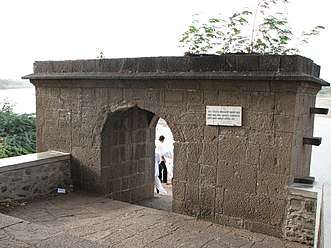 Stone arch at Tulapur confluence under which Sambhaji was executed
Stone arch at Tulapur confluence under which Sambhaji was executed- Talks about the historic event (September 12, 1633) at Tulapur
- Sangameshwar at Tulapur, confluence of rivers
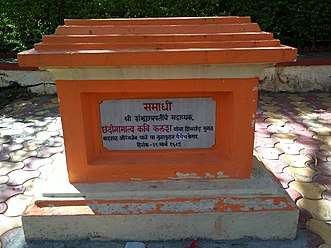 Samadhi of Kavi Kalash at Tulapur
Samadhi of Kavi Kalash at Tulapur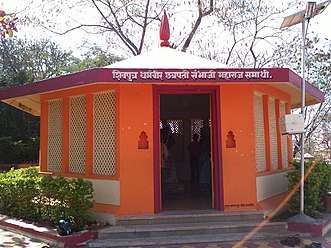 Samadhi of Sambhaji
Samadhi of Sambhaji Sambhaji's and Kavi Kalash's Samadhi(Mausoleum) at Vadhu
Sambhaji's and Kavi Kalash's Samadhi(Mausoleum) at Vadhu
References
- 2001 Census Village code for Tulapur = 03107000, "2001 Census of India: List of Villages by Tehsil: Maharashtra" (PDF). Registrar General & Census Commissioner, India. p. 603. Archived (PDF) from the original on 13 November 2011.
- Ishwardas Nagar Futuh-i-Alamgiri